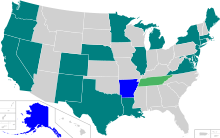Discrimination based on hair texture in the United States
| Part of a series on |
| Discrimination |
|---|
 |
In the United States, discrimination based on hair texture is a form of social injustice that has been predominantly experienced by African Americans and predates the existence of the country. There is no existing federal law that prohibits this form of discrimination, but there have been legislative proposals to do so. In the 21st century, multiple states and local governments have passed laws that prohibit such discrimination, California being the first state to do so in 2019 with the Crown Act.
History[edit]
In the late 1700s, free Africans in New Orleans were able to buy their freedom from slavery, resulting in an increase of interracial marriage in Louisiana.[1] In response, Charles III of Spain demanded Louisiana colonial governor Esteban Rodríguez Miró to "'establish public order and proper standards of morality,' with specific reference to a "large class" of "mulattos" and particularly "mulatto" women.'"[2] Louisiana women of African descent wore hairstlyes that incorporated feathers and jewels, which caught the attention of white men. To comply with Charles III's demand, Miró issued an edict that required Creole women to wear a tignon to conceal their hair.[1]
By the late 1800s, African American women were straightening their hair to meet a Eurocentric vision of society with the use of hot combs and other products improved by Madam C. J. Walker. However, the black pride movement of the 1960s and 1970s made the afro a popular hairstyle among African Americans and considered a symbol of resistance.[1] In 1964, the U.S. federal government passed the Civil Rights Act, which prohibited employment discrimination based on race, but it was left to interpretation by the courts as to what this constituted.[3] In 1970, Beverly Jenkins was denied a promotion in the Blue Cross by her white supervisor due to her afro.[4] In 1976, the federal court case Jenkins v. Blue Cross Mutual Hospital Insurance determined that afros were protected by Title VII of the Civil Rights Act of 1964. However, the case did not extend protections against hair discrimination.[3]
In the 2010s, natural hairstyles saw an increase in popularity in response to celebrities such as Viola Davis, Lupita Nyong’o, Ava DuVernay, and Stacey Abrams wearing natural hair. However, the popularity also resulted in increased attention to dress codes and hair regulations as African American workers and students across the U.S. were subjected to punishment due to their hair.[5] Because of awareness to the issue, California passed the Crown Act in July 2019, becoming the first U.S. state to prohibit discrimination against workers and students based on their natural hair.[6] California's passage of the bill has led to many other states to consider similar bills banning hair discrimination and a bill proposed at the federal level by U.S. representative Cedric Richmond and U.S. senator Cory Booker.[7]
In September 2020, U.S. representative Ilhan Omar announced the passage of the Crown Act in the House of Representatives, which would prohibit racialized hair discrimination nationally if enacted.[8]
Legislation[edit]
As of May 2020, seven U.S. states have prohibited discrimination based on hair texture.
| State | Date enacted | Notes |
|---|---|---|
| July 3, 2019 | Passed the Crown Act[6] | |
| July 12, 2019 | Passed an amendment to the New York Human Rights Law[9] | |
| December 19, 2019 | Passed the Crown Act[10] | |
| March 3, 2020 | Passed the Virginia Human Rights Act[11] | |
| March 6, 2020 | Passed the Crown Act[12] | |
| March 19, 2020 | Passed an amendment to the Washington State Law Against Discrimination[13] | |
| May 8, 2020 | Passed without governor's signature[14] |
See also[edit]
References[edit]
- ^ a b c Nasheed, Jameelah (April 10, 2018). "When Black Women Were Required By Law to Cover Their Hair". Vice News. Retrieved April 13, 2020.
- ^ Winters, Lisa Ze (January 15, 2016). The Mulatta Concubine: Terror, Intimacy, Freedom, and Desire in the Black Transatlantic. University of Georgia Press. p. 77. Retrieved April 13, 2020.
- ^ a b Nasheed, Jameelah (August 9, 2019). "A Brief History of Black Hair, Politics, and Discrimination". Teen Vogue. Retrieved April 13, 2020.
- ^ "538 F. 2d 164 - Jenkins v. Blue Cross Mutual Hospital Insurance Inc". OpenJurist. Retrieved April 13, 2020.
- ^ Griffith, Janelle (February 23, 2019). "When hair breaks rules: Some black children are getting in trouble for natural hairstyles". NBC News. Retrieved April 13, 2020.
- ^ a b Chavez, Nicole; Karimi, Faith (July 3, 2019). "California becomes the first state to ban discrimination based on natural hairstyles". CNN. Retrieved April 13, 2020.
- ^ Higgins, Jesse (February 27, 2020). "24 states consider bills to ban natural hair discrimination". Evansville: UPI. Retrieved April 13, 2020.
- ^ Smith, Erica (September 22, 2020). "Natural-Hair Discrimination Is One Step Closer to Being Banned Nationwide". The Cut. Retrieved October 7, 2020.
- ^ Griffith, Janelle (July 15, 2019). "New York is second state to ban discrimination based on natural hairstyles". NBC News. Retrieved March 6, 2020.
- ^ Lewis, Sophie (December 21, 2019). "New Jersey becomes third state to ban discrimination based on hair". CBS News. Retrieved April 13, 2020.
- ^ Evelyn, Kenya (6 March 2020). "Virginia becomes first southern US state to ban hair discrimination". New York: The Guardian. Retrieved 12 April 2020.
- ^ Hindi, Saja (March 6, 2020). "Colorado becomes 5th state to ban natural hair discrimination". The Denver Post. Retrieved March 6, 2020.
- ^ "Ban on Race-Based Hairstyle Discrimination Signed Into Law". U.S. News. Olympia: Associated Press. March 19, 2020. Retrieved April 12, 2020.
- ^ Kurtz, Josh (May 8, 2020). "Here Are Two Dozen Bills Becoming Law Without Hogan's Signature". Maryland Matters. Retrieved October 7, 2020.
